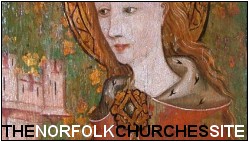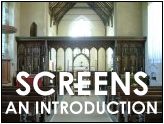
home I index I introductions I e-mail I about this site

7. Amazing Screens
Six Broadland churches with wonderful rood screens
One of the most colourful and interesting survivals in many of our medieval churches is the low screen of panels which stretches across the mouth of the chancel arch. We call this structure the rood screen. Sometimes the panels are painted, and sometimes the structure extends upwards into delicately carved tracery, although more often this has been hacked off. Still, that which remains provides us with a valuable insight into the medieval mind. What were rood screens for? We have already met the idea, on the introduction to Cawston and Salle, that medieval churches were not designed for the congregational Anglican worship that most of them now host. In a medieval church, worship was less corporate, more active, more diverse. Different parts of a church building had different uses, and were the domain of different sections of the community. The chancel was the Priest's, and it was the location of the great mystic function of the Church; here, Christ was really present in the act of consecration. The nave was the great leveller, where the people of the parish came together to encounter the numinous through their presence at the Mass, and also to undertake their private devotions. The font to the west was the location of initiation; here, the babies of the parish would be totally immersed in holy water to bring them into membership of the community. Even in a small church there would be a diversity of opportunity for intercessionary prayer at altars and in chapels dedicated to various Saints. There might also be guild and chantry chapels, where that most energetic and urgent business of the late medieval Catholic Church could be carried out: praying for the dead. Towards the end of the medieval period, the nave began to fill with benches, and the Church began to encourage a more corporate attitude towards the experience of the Mass. The introduction of pulpits finally absorbed the nave into the directed liturgy; the Priest stepped out of the chancel, and made the whole building his. However, even then the nave remained in use for a large number of secular activities; it was, after all, the most substantial structure in virtually every parish. Given that different parts of the church had different uses, it is not surprising that there was some need for division. The most pressing need was for the heirarchy between chancel and nave to be expressed in material form; so, rood screens appear in the 14th century to fullfil this function. Roodscreens can be very simple or very elaborate, but they all conformed to a basic set of precepts. Firstly, a dado ran across the chancel arch, with a doorway in the middle - often, especially in Norfolk, this had double doors. The dado panels were usually painted with images of Saints, or angels, or kings. The dado usually stands about four feet high, but this could be as high as six feet in a grand church like Salle. The width of the chancel arch defined the length of the screen, and therefore the number of panels on the dado. In a small church there might only be six; a larger church might run to twelve. At Ranworth, where the screen runs into both aisles, there are 26 Saint panels on the dado. Above the dado, the screen was all air and lumescence; delicate tracery billowed out above staunch uprights, and light from the east window flooded back into the nave. It is quite obvious that the roodscreen was never intended to stop the laity from seeing what was going on in the chancel; this was no iconostasis. Above the tracery, coving supported a great loft. We know that a candle beam ran the length of this loft, and that the stairway up to the loft allowed someone to go up and light candles; but the loft had other uses. We know that the gospel was sometimes proclaimed from the loft, and that anthems were on occasion sung there. We know that, at some churches, pairs of organs were located in the loft. Above the loft, facing into the nave, was the central focus of a late medieval church - the rood. This was a great crucifix, flanked by the Virgin and St John, often backed by some kind of painting depicting the last judgement. It was a reminder to the people in the nave of the central mystery of the Christian faith, the death and resurrection of Jesus Christ. All this coincided in many places in East Anglia with the rebuilding of the nave; aisles for processions were added, and a clerestory filled the roof of angels with light; it had another function too, for it also flooded with light the great rood. Who made the rood, the loft, the screen? In East Anglia, we can only make a judgement about the screens - sometimes, only the dado of the screen, which is perhaps all that has survived. In small churches, the work is often of a local quality, and must have been put together by local people; the wheelwright, the carpenter, the blacksmith. In some churches, the work is of outstanding quality, and suggests that a large amount of money was available to pay someone of considerable significance to produce the work. Why was money bequeathed to produce the screen? The answer lies in the inscriptions found on many screens, most boldly at Ludham, asking for the prayers of the faithful for the souls of the departed. These inscriptions face the people in the nave, not the clergy in the chancel; the dead were committing themselves to the mercy of the living, and in doing so to remaining part of the ongoing community. Who did the painting? Again, some work is in a rough, local style, as at Upton, but some is outstanding, of national significance, showing international influence. Perhaps skilled artists travelled about England fullfilling commissions provided by bequests; links can be made between the artwork on screens in different counties, while adjacent parishes may have screens that are quite different in design. Why Saints? The designs seem to have been part of a late medieval project to assert the official doctrine of the Catholic Church, probably in the face of what were perceived as rural superstitions and fancies. It is probably no coincidence that this happened in the century and a half after the Black Death had carried off half the population of Norfolk. That pestilence also caused dramatic economic changes, and by creating a demand for labour set in place the pre-conditions for capitalism. The burgeoning merchant class saw no great distinction between their secular power and their involvement in the Church Militant; they sought to control the imaginations as well as the labours of those in their service. These, then, are the families who paid for the roods and screens to be uplifted, and expected intercessionary prayer in return. At the Reformation, the sacramental function of the building became anathema. Altars were destroyed, and the roods came tumbling down; not one survived, not anywhere in England. Roodlofts were also generally destroyed, but roodscreens themselves often survived. Not least, this was because they served a practical purpose; chancels, although no longer holy, were pressed into use throughout the 17th and 18th centuries as school rooms, meeting rooms and vestries, and were usefully cordoned off. It was only the Victorians who restored the chancels to their proper use. The greatest work in Norfolk is from the first half of the fifteenth century, reaching its peak in the 1430s at Ranworth. There are unanswered questions. This is fully a hundred years before the Reformation, and yet some screens, Ranworth included but also Salle, appear to be unfinished. Why? We still don't know everything about rood screens. At the Reformation, the Saints on the screens most often had their faces scratched out, but were probably overpainted as well. There are traces of tar on some screens, and in many places the Victorians removed layers of whitewash to expose these extraordinary portraits. Their condition today varies; all have been restored, some more sensitively than others, but St George and St Michael at Ranworth and St Margaret at Barton Turf seem as perfect as anything you'll find in countries that did not suffer the iconoclasm of England. But most do not. St Thomas of Canterbury, whose cult was considered treason by the 16th century reformers, and St Gregory, who wears a papal tiara, came in for especially brutal treatment. That so much survived should be a wonder, except that we must remember these screens would not have seemed as exceptional then as they do today. Even at Ranworth, the screen is but a fragment of the glory that was once the English Catholic Church. Simon Knott, September 2004 click on
the images below to visit the churches Barton Turf Catfield Irstead Ludham Ranworth Upton
Amazon commission helps cover the running costs of this site.
home I index I latest I introductions I e-mail I about this site I glossary |